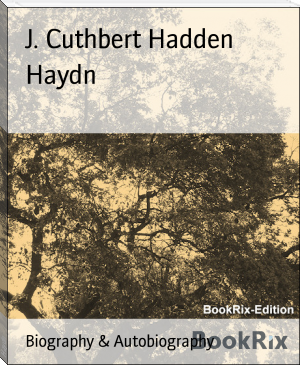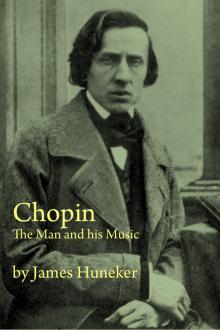Haydn by J. Cuthbert Hadden (books you need to read TXT) 📖

- Author: J. Cuthbert Hadden
Book online «Haydn by J. Cuthbert Hadden (books you need to read TXT) 📖». Author J. Cuthbert Hadden
The sum paid to Haydn at this date was not large as we should now consider it, but it was sufficient to free him from financial worry had it not been for the extravagance and bad management of his wife. The prince gave him about 78 pounds, in addition to which he had certain allowances in kind, and, as we have already said, free quarters for himself and his wife when she thought fit to stay with him. Probably, too, he was now making something substantial by his compositions. Griesinger declares that he had saved about 200 pounds before 1790, the year when he started for London. If that be true, he must have been very economical. His wife, we must remember, was making constant calls upon him for money, and in addition he had to meet the pressing demands of various poor relations. His correspondence certainly does not tend to show that he was saving, and we know that when he set out for London he had not only to draw upon the generosity of his prince for the costs of the journey, but had to sell his house to provide for his wife until his return.
Opera at Esterhaz
It is time, however, to speak of some of Haydn's compositions during this period. At Esterhaz he "wrote nearly all his operas, most of his arias and songs, the music for the marionette theatre--of which he was particularly fond--and the greater part of his orchestral and chamber works." The dramatic works bulk rather largely during the earlier part of the period. In 1769, for example, when the whole musical establishment of Esterhaz visited Vienna, a performance of his opera, "Lo Speciale," was given at the house of Freiherr von Sommerau, and was repeated in the form of a concert. Other works of the kind were performed at intervals, particularly on festival occasions, but as most of them have perished, and all of them are essentially pieces d'occasion, it is unnecessary even to recall their names. In 1771 Haydn wrote a "Stabat Mater" and a "Salve Regina," and in 1773 followed the Symphony in C which bears the name of the Empress Maria Theresa, having been written for the empress's visit to Esterhaz in September of that year. In the course of the visit Haydn was naturally introduced to Her Majesty, when, as we have stated, he took occasion to remind her of the "good hiding" she had ordered him to have at Schonbrunn during the old chorister days at St Stephen's. "Well, you see, my dear Haydn," was the reply, "the hiding has borne good fruit."
First Oratorio
In 1775 came his first oratorio, "Il Ritorno di Tobia." This is an exceedingly interesting work. It was first performed under Haydn's direction by the Tonkunstler Societat, with solo singers from Esterbaz, at Vienna, on April 2, 1775. In 1784 Haydn added two choruses, one a "Storm Chorus," which is sometimes confused with the "Storm Chorus" (in the same key, but in triple time) composed during his sojourn in London. It is from "Il Ritorno di Tobia" that the so-called motet, "Insanae et Vanae Curae," is adapted, and the "Storm Chorus" immediately follows a fine soprano air in F minor and major, sung by Anna in the original work, a portion of which forms the beautiful second subject (in F) of the "Insanae." The original words of this chorus--"Svanisce in un momento"--are to the effect that the soul threatens to yield to the fury of its enemies, yet trust in God keeps one steadfast. The music admirably reflects these contrasting sentiments, first in the tumultuous D minor section, and then in the tranquillity of the F major portion which follows, no less than in the trustful quietude of the D major conclusion. Latin words were adapted to three of the original choruses, but nothing seems to be known as to the origin of the "Insanae" adaptation. A full score of the motet, published by Breitkopf & Hartel in 1809, was reviewed in the Allgemeine Musikalische Zeitung of August 15, 1810, as if it were an entirely original work. The source of the Latin words also remains a mystery. They were presumably put together to fit Haydn's music, but by whom we have no means of ascertaining.
It is interesting to know that Haydn brought the score of his "Il Ritorno di Tobia" with him to England on the occasion of his first visit in 1791, probably with a view to its performance here. Messrs Novello's private library contains an oblong volume in the handwriting of Vincent Novello, in which he has copied some numbers from "Tobia," including the air of Anna already mentioned, but not the "Insanae" chorus. The inside cover of the book bears the following note in Novello's hand, written, not later than 1820, under the contents of the volume:
"The whole of the above are unpublished manuscripts, and were copied from an extremely rare volume, containing the full orchestral score of the entire oratorio, kindly lent to me for the purpose by my friend, Mr Shield, who had obtained it from Haydn himself during the visit of the latter to England in the year 1791.--VINCENT NOVELLO, 240 Oxford St."
[See an interesting account of "Il Ritorno di Tobia" in The Musical Times for September 1901, p. 600.]
Some of our musical societies in search of novelties might do worse than revive this almost completely forgotten oratorio. The airs are exceedingly melodious, and the choruses bold and tuneful, with well-developed fugue subjects. The "Insanae" already referred to is frequently performed.
Opponents
In 1776 Haydn composed "La Vera Costanza" for the Court Theatre of Vienna, but owing to certain intrigues it was declined by the management and produced at Esterhaz instead. The opera was subsequently staged at Vienna in 1790, and six of its airs and a duet were published by Artaria. This incident makes it sufficiently plain that Haydn had his opponents among the musicians and critics of Vienna as well as elsewhere. Burney says a friend in Hamburg wrote him in 1772 that "the genius, fine ideas and fancy of Haydn, Ditters and Filitz were praised, but their mixture of serious and comic was disliked, particularly as there is more of the latter than the former in their works; and as for rules, they knew but little of them." If we substitute "humorous" for "comic," this may be allowed to fully represent the views of the critics and amateurs of Vienna in regard to Haydn's music.
And, unfortunately, the incident just mentioned was not a solitary one. In 1778 Haydn applied for membership to the Tonkunstler Societat, for whom he had in reality written his "Il Ritorno di Tobia." One would have expected such a body to receive him with open arms, but instead of that they exacted a sum of 300 florins on the ground of his non-residence in Vienna! Not only so, but they would fain have brought him under a promise to compose for them whenever they chose to ask him. This latter condition Haydn felt to be impossible in view of his engagement at Esterhaz, and he withdrew his admission fee. That the society were not ashamed of themselves is obvious from a further episode. Some years after this they desired Haydn to rearrange his "Tobia" for a special performance, and when he demanded payment for his trouble they promptly decided to produce Hasse's "Elena" instead. Everything comes to the man who waits. After his second visit to London the Tonkunstler Societat welcomed Haydn at a special meeting, and with one voice appointed him "Assessor Senior" for life. In return for this distinction he presented the society with "The Creation" and "The Seasons," to which gifts, according to Pohl, its prosperity is mainly owing.
"L'Isola Disabitata"
If Haydn was thus less highly appreciated at home than he deserved to be, there were others who knew his sterling worth. In 1779 he composed one of his best operas, "L'Isola Disabitata," the libretto of which was by his old benefactor Metastasio, and this work procured his nomination as a member of the Philharmonic Society of Modena. The following extract of a letter written to Artaria in May 1781 is interesting in this connection. He says: "M. le Gros, director of the 'Concerts Spirituels' [in Paris], wrote me a great many fine things about my Stabat Mater, which had been given there four times with great applause; so this gentleman asked permission to have it engraved. They made me an offer to engrave all my future works on very advantageous terms, and are much surprised that my compositions for the voice are so singularly pleasing. I, however, am not in the least surprised, for, as yet, they have heard nothing. If they could only hear my operetta, 'L'Isola Disabitata,' and my last Shrove-tide opera, 'La Fedelta Premiata,' I do assure you that no such work has hitherto been heard in Paris, nor, perhaps, in Vienna either. My great misfortune is living in the country." It will be seen from this what he thought of "L'Isola," which was not heard in Vienna until its performance at a concert given at the Court Theatre by Willmann the 'cellist in 1785. Haydn sent the score to the King of Spain, who showed his sense of the honour by the gift of a gold snuff-box, set in brilliants. Other marks of royal attention were bestowed upon him about this time. Thus, in 1784, Prince Henry of Prussia sent him a gold medal and his portrait in return for the dedication of six new quartets, while in 1787 King Frederick William II gave him the famous gold ring which he afterwards always wore when composing.
A Love Episode
But we have passed somewhat out of our chronological order. The absence of love at home, as we all know, often encourages love abroad. Haydn liked to have an occasional flirtation, as ardent as might be within the bounds of decorum. Sometimes, indeed, according to our insular ideas of such things, he exceeded the bounds of decorum, as in the case of which we are now compelled to speak. Among the musicians who had been engaged for the Esterhazy service in 1779 were a couple named Polzelli--the husband a violinist, the wife a second-rate vocalist. Luigia Polzelli was a lively Italian girl of nineteen. She does not seem to have been happy with Polzelli, and Haydn's pity was roused for her, much as Shelley's pity was roused for "my unfortunate friend," Harriet Westbrook. The pity, as often happens in such cases, ultimately ripened into a violent passion.
We are not concerned to adopt an apologetic tone towards Haydn. But Signora Polzelli was clearly an unscrupulous woman. She first got her admirer into her power, and then used her position to dun him for money. She had two sons, and the popular belief of the time that Haydn was the father of the younger is perpetuated in several of the biographies. Haydn had certainly a great regard for the boy, made him a pupil of his own, and left him a small sum in his first will, which, however, he revoked in the





Comments (0)